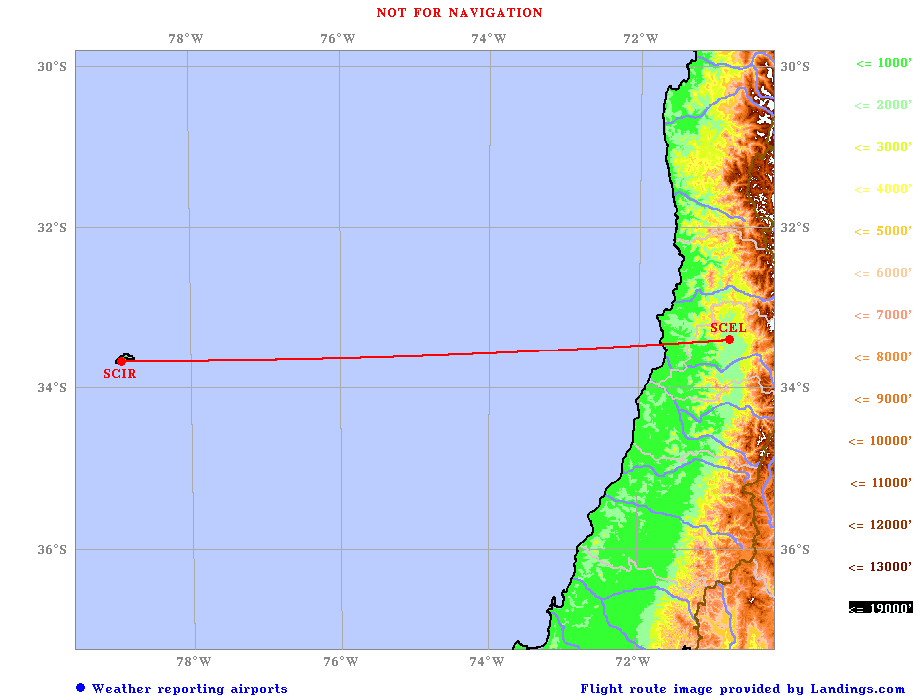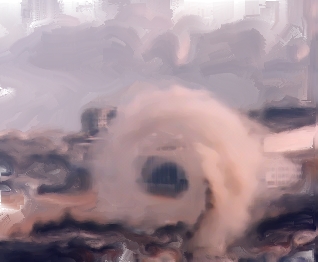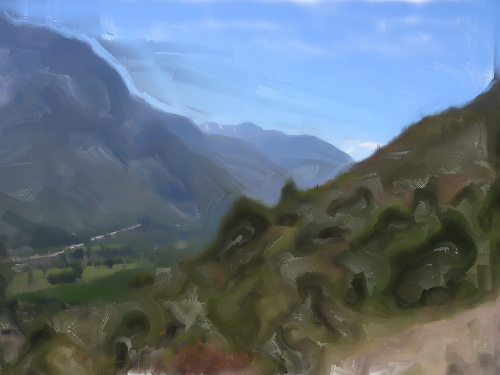

The islands are about 400 miles off the coast of Chile. I set off early headed east. It reminded me of the earlier leg from Ascension Island to Africa. I felt much more relaxed as I climbed away from Robinson Crusoe Island and towards Santiago. Somehow, even though I was still following that little line on a screen, the GPS telling me how to go straight to Santiago, the fact that I was flying towards a whole continent made the flight much less stressful. After all, I couldn’t miss a continent. I wondered how far out I’d see the Andes. Some of those peaks were over 24,000 feet and ought to be visible way out to sea.
The total time was less than two hours, a short flight. I saw the peaks quite a ways out to sea. I followed the GPS in to the coast. As I crossed the coastline, I relaxed. I was over land once again after days of nothing but blue below me. The Santiago airport is a modern two runway International airport. I was lined up behind several ‘Heavies’ by ATC. I needed to maintain 5 miles distance according to guidelines. Big planes like the wide-bodied commercial jets create wake turbulence, virtually a small tornado that follows the big planes. It can be so strong that smaller planes can be turned upside down by it. But as long as I didn’t get lower than the heavy in front of me I should be okay. I remember seeing a smokestack right off the end of a runway when a heavy went by. It curled that smoke into a vortex bigger than any small plane. If someone had flown through that, they would have doing circles and probably crashing.
 The one thing I had to do was maintain my speed since I didn’t need some 747 assholing me from behind.
The one thing I had to do was maintain my speed since I didn’t need some 747 assholing me from behind.
I followed the heavy in front and made sure I was above their flight path. I delayed lowering my gear or flaps until I saw it touch the ground. I wanted to touch further down the runway than him. I pulled off the power and bleed off speed, lowered the flaps all the way and dropped the gear. The Mustang is a heavy plane for the size of the wings and fell out of the air with full flaps. Full flaps can save a high approach in the Mustang. I had to add power to slow my descent and hit where I wanted down the runway. The air was a little roiled, but not bad as I slowed and turned off the runway. While I was trying to contact ground for taxi, an Airbus 300 landed behind me and roared past. I got taxi directions off to the end of the airport away from the terminals, which was fine with me.
When I planned this trip I knew I would have just finished quite a few long hops when I made it to Santiago so I planned a little vacation. Chile is building quite a wine industry. I booked a tour of the Maipo region from Santiago at the hotel. I suppose it must be obvious by now but I like wine, good wine. We left before dawn on a bus. I had expected the worst when they said a bus as I was imagining those Hollywood versions, chickens on top. But it was a modern tourist bus with comfortable seats and a hostess who spoke English, German, French, as well as Spanish. The Maipo valley is in the foothills of the Andes which dominate the view. We went to many vineyards that I had tried the wine in the U.S. and a few smaller ones I had never even heard of before. One thing I found interesting was the willingness of the vineyards to ship to the U.S. I ordered several cases of wine and had them shipped.

I was used to the vineyards of California. The foothill wineries in Amador have the Sierra in the background and there are wonderful views, but they are nothing to the Andes. The mountain in the northern Sierra are 12,000 feet. The mountains in the southern Andes can be 20,000 feet. That is a big difference. It seems you can always see the mountains that dominate the western horizon.
One thing I noticed was the language difference. It wasn’t that everyone spoke Spanish. Hell, if you are around any of the vineyards in California everyone speaks Spanish. You have to because all of the vineyard workers speak Spanish. If it wasn’t for Mexico, we wouldn’t have a wine industry in California. The difference was so few people spoke English in Chile. The larger vineyards usually had servers who knew several languages. But we stopped at a couple smaller places and the hostess had to translate if we had a question. The taste of wines doesn’t need translation and the labels said all that needed to be said. Cabernet is Cabernet in every country.
There are a few grapes in South America that aren’t grown elsewhere like Carmenčre. They grow the Pais grape for local consumption which we call the Mission grape in California since it came over with the Missions. The friars had to have wine for mass after all. I knew the taste and it makes an okay wine, but nothing special. I guess if you were 2,000 miles from home it would be okay.
The bus took us back to town and dinner in the hotel. I was tired but a comfortable tired. The extra day just decompressing in Chile had been good for me. I slept well.
Go back to the Table of Contents
Copyright Rod O'Steele © 2009